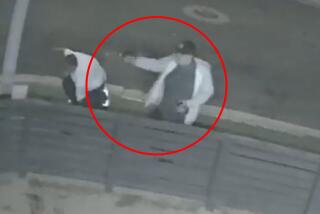Credibility of High-Tech Evidence to Be Focal Point of Murder Trial : Crime: Prosecutors will introduce DNA analysis and fingerprints, but defense attorneys say the case rests on ‘speculation and pure guesswork.’
- Share via
Tracy Morrigan was 26 and enjoying her first night in her brand new Torrance townhome when an intruder tried to rape her and then strangled her to death.
Now, more than three and a half years later, prosecutors are using a newfound arsenal of scientific crime-fighting weapons in their efforts to send Keith Brian Campbell, the former security guard accused of killing her, to the gas chamber.
Opening statements in the case this week indicate it will not be a smooth battle.
Even Deputy Dist. Atty. Bob Martin acknowledges that the complicated DNA evidence he plans to use is anything but clear-cut, in part because this case is the first in Los Angeles County to allow this type of DNA analysis.
In addition, defense attorney Marcia Morrissey told jurors in her opening statement Tuesday that she will present evidence to point an accusing finger at two other men never arrested or charged in the case.
Charging that prosecutors are using “speculation and pure guesswork” against Campbell, Morrissey urged jurors to conclude that “the circumstances do not add up.”
Both sides agree on a basic scenario of what happened the night Morrigan died.
Thrilled to have her own home for the first time, Morrigan borrowed comforters and an alarm clock from her parents’ Rancho Palos Verdes house on May 30, 1989, and went to the newly built townhome a few days before her scheduled move-in.
A neighbor last spotted her through a kitchen window about 10 p.m. as she cleaned her countertop, Martin told jurors. Half an hour later, when the neighbor took his puppy for a walk, all the lights in Morrigan’s unit had been turned off and it appeared as if she had gone to bed.
About 8 a.m. the following morning, Martin said, a service supervisor for the complex used a master key to let himself into the unit so he could complete some minor repairs.
As he worked, the man opened a third-story bedroom door, peeked inside, and saw Morrigan lying on her stomach on the carpeted floor, a comforter covering her below the waist. Assuming she was asleep, the man hastily shut the door and continued his work.
About 11:30 a.m., Morrigan’s mother arrived to deliver groceries. It was she who discovered that Morrigan was dead, Martin said. Police later said she had been strangled with her bra.
Investigators lifted dozens of fingerprints from throughout the unit and discovered six pubic hairs at the crime scene.
In October, four of the fingerprints were matched to Campbell, the security guard assigned to watch Morrigan’s complex the night she died. Campbell was fired by the complex’s security company in June, 1989, after company officials discovered he was on parole after serving four years of a seven-year state prison sentence for assault with a deadly weapon.
Campbell, who denied ever having been inside Morrigan’s unit, was arrested on Nov. 6, 1989, and has been in custody ever since--awaiting trial as complicated, time-consuming scientific tests were conducted on the evidence.
A dim palm print, discovered on Morrigan’s windowsill the morning of the murder, was subjected in November, 1989, to detailed laser analysis to try to draw out more detail. Martin told jurors that experts concluded the print matched Campbell’s, but Morrissey said she would bring in experts to say that the photograph was too blurry to analyze.
The actual palm print, she noted, was painted over by detectives before Campbell’s attorney could look at it.
Hair analysts were asked to conduct visual comparisons of the pubic hairs found at the crime scene with Campbell’s. Some experts said they matched, some did not.
That is when Martin decided to seek a DNA analysis of the hair.
Using a relatively new process called polymerase chain reaction testing, scientists replicated tiny amounts of DNA found in the hair follicles and concluded that at least some of them were similar to Campbell’s own DNA.
But because of the limited genetic material that can be measured, the tests provide little more certainty about who the perpetrator might be than does standard blood typing, Martin said.
Experts believe Campbell’s DNA type may be found in anywhere from 5% to 17% of the general population.
“It’s like blood testing,” Martin said. Campbell “is included in the group of people who may have killed her . . . but (the DNA evidence) doesn’t positively identify him as being the guy.”
Defense attorneys said they will present evidence, including an alleged confession by another man, to prove that Campbell had nothing to do with Morrigan’s death.
In her opening statement, Morrissey said that two service workers at the townhome complex began “behaving suspiciously” after the murder and that one of the men threatened to kill his wife if she ever told anyone that he was not home on the night of May 30, 1989.
That man now is serving a state prison sentence for house burglary, Morrissey said.
Campbell’s trial, being conducted in Norwalk Superior Court because of overcrowding in the Torrance court system, is expected to continue through January.
More to Read
Sign up for Essential California
The most important California stories and recommendations in your inbox every morning.
You may occasionally receive promotional content from the Los Angeles Times.










